

Networks of sponges could capture DNA to track ocean health. To track the biological health of oceans, researchers use cameras, satellite images, and, increasingly, DNA shed directly into the water.
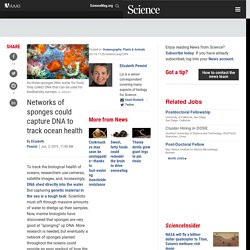
But capturing genetic material in the sea is a tough task: Scientists must sift through massive amounts of water to dredge up their samples. Now, marine biologists have discovered that sponges are very good at “sponging” up DNA. More research is needed, but eventually a network of sponges planted throughout the oceans could provide an easy readout of how the diversity of plants and animals nearby is doing. A growing sensory smog threatens the ability of fish to communicate, navigate, and survive.
Try, for a moment, to be a fish.
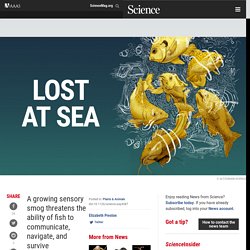
As you swim through dim waters, you see shapes moving past and watch for threats. You hear other animals calling or producing rasps and crackles by scraping together rigid body parts. The water is a tapestry of smells that reveals predators and potential mates, food, and the route home. Now, imagine that nothing makes sense—the tapestry has unraveled. Smells still reach you, but their meanings are muddled. Loss of genetic diversity in Atlantic cod. Futurism. Trade war threatens sustainability. China's highways threaten wild camels. A Strange New Blend of Rock and Plastic Is Forming on a Portuguese Island. Why Is a Strange Plastic Crust Spreading on This Island’s Coast?
An organism found in dirt may lead to an anxiety vaccine, say scientists. New research identifies a bacterium that helps block anxiety.

Scientists say this can lead to drugs for first responders and soldiers, preventing PTSD and other mental issues.The finding builds on the hygiene hypothesis, first proposed in 1989. Are modern societies trying too hard to be clean, at the detriment to public health? Scientists discovered that a microorganism living in dirt can actually be good for us, potentially helping the body to fight off stress. Harnessing its powers can lead to a "stress vaccine". Researchers at the University of Colorado Boulder found that the fatty 10(Z)-hexadecenoic acid from the soil-residing bacterium Mycobacterium vaccae aids immune cells in blocking pathways that increase inflammation and the ability to combat stress.
The study's senior author and Integrative Physiology Professor Christopher Lowry described this fat as "one of the main ingredients" in the "special sauce" that causes the beneficial effects of the bacterium. Futurism. New Device Generates Electricity From Falling Snow. Futurism. Scientists Built a Robot Sloth to Study Other Sloths. Low Octane Scientists are building a new robot programmed to sleep on the job.
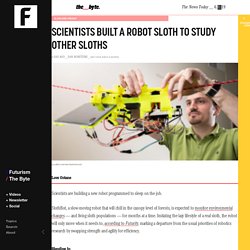
SlothBot, a slow-moving robot that will chill in the canopy level of forests, is expected to monitor environmental changes — and living sloth populations — for months at a time. Futurism. AI Analysis Uncovers Coral Reefs Resistant to Climate Change. UNDERWATER WASTELAND.

Global warming is destroying Earth’s coral reefs — the colorful underwater ecosystems simply can’t survive as the ocean warms and acidifies. However, researchers have now discovered a type of coral off the coast of Indonesia’s Sulawesi Island that seems to be resistant to global warming. The discovery could help us ensure at least some of the world’s coral reefs survive climate change.
As part of 50 Reefs, an initiative designed to identify climate change-resistant corals, researchers spent six weeks in June and July using underwater scooters equipped with 360-degree cameras to take more than 56,000 images of shallow water reefs. Scientists Splice Spider Gene Into Fungus to Kill Mosquitoes. Spider Gains If we want to stop malaria from killing more than 400,000 people every year, we’ll need to stop mosquitoes — the irksome insects are the primary transmitter of the deadly disease.
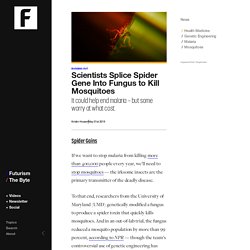
To that end, researchers from the University of Maryland (UMD) genetically modified a fungus to produce a spider toxin that quickly kills mosquitoes. And in an out-of-lab trial, the fungus reduced a mosquito population by more than 99 percent, according to NPR — though the team’s controversial use of genetic engineering has some worried the method is too dangerous for the real world. Killer Fungus According to a paper published Thursday in the journal Science, the fungus the UMD researchers modified kills mosquitoes in the wild — but it isn’t particularly fast, meaning the insects might have time to infect someone with malaria before meeting their demise. China's dams threaten green peafowl. Rat eradication launched on populated island.
Exclusive: Tesla expects global shortage of electric vehicle battery minerals -sources. In Australia, a bold effort to teach rare animals to fear cats. Scientists discover a game-changing way to remove salt from water. Vanishing Bering Sea ice threatens one of the richest U.S. seafood sources. When ice failed to cover much of the eastern Bering Sea between Alaska and Russia in early 2018, oceanographer James Overland chalked it up to a freak chance.

Then, it happened again this year, with late-winter sea ice falling to some of the lowest levels seen in at least 4 decades. The ocean’s tallest waves are getting taller. The frigid Southern Ocean is well known for its brutal storms, which can sink ships and trigger coastal flooding on distant tropical islands.

Now, a new study suggests the biggest waves there—already the world’s largest—are getting bigger, thanks to faster winds attributed to climate change. Spaceflight found to reactivate dormant viruses in astronauts. Deadly “Super Fungus” Could Be the Beginning of a Global Epidemic. Antifungal Resistance Bacteria’s ability to develop antibiotic resistance is well known — but it turns out fungi are also evolving to withstand modern medicine.
Now one such fungus is cropping up in hospitals all across the globe and killing half the people who contract it within 90 days, according to an alarming story by The New York Times — raising concerns about a new global epidemic. Global Threat. A Mouse With Two Mothers. All Japanese children know the story of Kaguyahime, the moon princess who was born from a bamboo shoot and refused to marry.
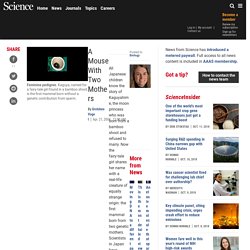
Now the fairy-tale girl shares her name with a real-life creature of equally strange origin: the first mammal born from two genetic mothers. Scientists in Japan have created an apparently healthy mouse, which they named Kaguya, by combining the genetic material from two egg cells. For some animals, it's no trick to develop from a single, unfertilized egg. Insects, reptiles, and others can reproduce this way, a process called parthenogenesis. These Healthy Mice Pups Have Two Moms and No Dads – Futurism. Scientists Used CRISPR to Domesticate This Delicate Fruit – Futurism.